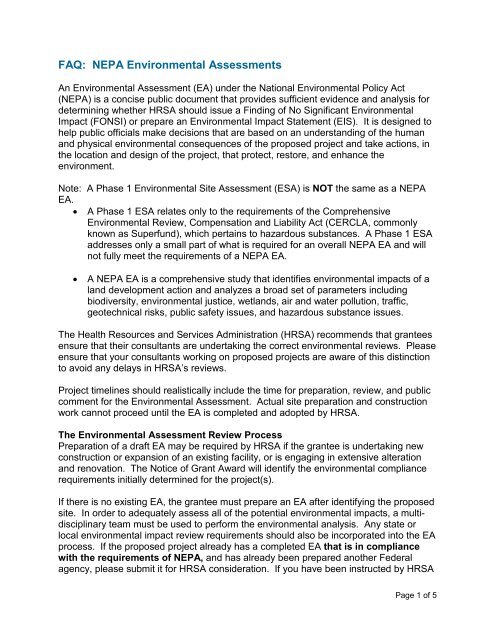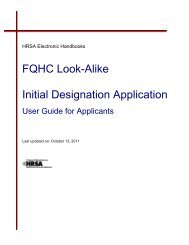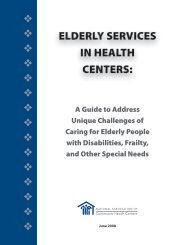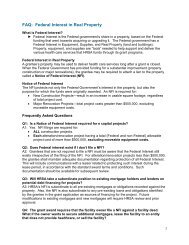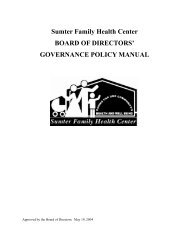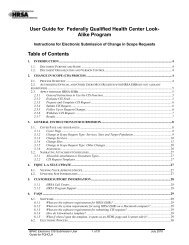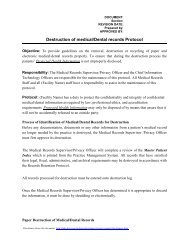FAQ: NEPA Environmental Assessments - HRSA
FAQ: NEPA Environmental Assessments - HRSA
FAQ: NEPA Environmental Assessments - HRSA
Create successful ePaper yourself
Turn your PDF publications into a flip-book with our unique Google optimized e-Paper software.
<strong>FAQ</strong>: <strong>NEPA</strong> <strong>Environmental</strong> <strong>Assessments</strong>An <strong>Environmental</strong> Assessment (EA) under the National <strong>Environmental</strong> Policy Act(<strong>NEPA</strong>) is a concise public document that provides sufficient evidence and analysis fordetermining whether <strong>HRSA</strong> should issue a Finding of No Significant <strong>Environmental</strong>Impact (FONSI) or prepare an <strong>Environmental</strong> Impact Statement (EIS). It is designed tohelp public officials make decisions that are based on an understanding of the humanand physical environmental consequences of the proposed project and take actions, inthe location and design of the project, that protect, restore, and enhance theenvironment.Note: A Phase 1 <strong>Environmental</strong> Site Assessment (ESA) is NOT the same as a <strong>NEPA</strong>EA.• A Phase 1 ESA relates only to the requirements of the Comprehensive<strong>Environmental</strong> Review, Compensation and Liability Act (CERCLA, commonlyknown as Superfund), which pertains to hazardous substances. A Phase 1 ESAaddresses only a small part of what is required for an overall <strong>NEPA</strong> EA and willnot fully meet the requirements of a <strong>NEPA</strong> EA.• A <strong>NEPA</strong> EA is a comprehensive study that identifies environmental impacts of aland development action and analyzes a broad set of parameters includingbiodiversity, environmental justice, wetlands, air and water pollution, traffic,geotechnical risks, public safety issues, and hazardous substance issues.The Health Resources and Services Administration (<strong>HRSA</strong>) recommends that granteesensure that their consultants are undertaking the correct environmental reviews. Pleaseensure that your consultants working on proposed projects are aware of this distinctionto avoid any delays in <strong>HRSA</strong>’s reviews.Project timelines should realistically include the time for preparation, review, and publiccomment for the <strong>Environmental</strong> Assessment. Actual site preparation and constructionwork cannot proceed until the EA is completed and adopted by <strong>HRSA</strong>.The <strong>Environmental</strong> Assessment Review ProcessPreparation of a draft EA may be required by <strong>HRSA</strong> if the grantee is undertaking newconstruction or expansion of an existing facility, or is engaging in extensive alterationand renovation. The Notice of Grant Award will identify the environmental compliancerequirements initially determined for the project(s).If there is no existing EA, the grantee must prepare an EA after identifying the proposedsite. In order to adequately assess all of the potential environmental impacts, a multidisciplinaryteam must be used to perform the environmental analysis. Any state orlocal environmental impact review requirements should also be incorporated into the EAprocess. If the proposed project already has a completed EA that is in compliancewith the requirements of <strong>NEPA</strong>, and has already been prepared another Federalagency, please submit it for <strong>HRSA</strong> consideration. If you have been instructed by <strong>HRSA</strong>Page 1 of 5
to prepare a draft EA, please be aware that it may take between one and threemonths to prepare a draft EA for <strong>HRSA</strong> review. The document will then need to beuploaded to the appropriate condition submission in the Electronic Handbook for <strong>HRSA</strong>to begin its review and approval.Because this is a comprehensive review, <strong>HRSA</strong> requires on average 45 days for reviewof the draft <strong>Environmental</strong> Assessment. If the document is incomplete, or indicate otherissues such as floodplain, wetlands, endangered species, etc., these must be resolvedand approved prior to grant funds being authorized for use towards actual constructionor renovation work project (which includes demolition). If the EA satisfies all the factorsin <strong>HRSA</strong>’s review set forth in the previous paragraph, <strong>HRSA</strong> will issue a draft FONSI.The grantee will then be provided instructions for to the public notice of availability of aFONSI. The notice must be timed so that interested agencies and the public have aminimum of 15 days (unless instructed otherwise) for review and comment on the draftEA.The grantee must review any public or agency comments received as a result of reviewof the draft EA and draft FONSI, and should modify its plans, if appropriate. Ifnecessary, modification may include modifying the project to mitigate the environmentalimpact of the proposed project, or abandoning the proposed site and selecting analternative that will have a less significant impact on the environment. The granteemust submit the comments, responses to these comments, and any revisions to theproposed plan to <strong>HRSA</strong> for review. If the grantee recommends proceeding with theproject in light of adverse comments on the environmental impact, the grantee mustinclude the rationale for its recommendation.Unless a significant environmental impact surfaces (either through the public commentsor other means), <strong>HRSA</strong> will issue a FONSI and authorize the grantee to beginconstruction work once the appropriate public comment period has been completed.It is strongly recommended that the grantee secure a qualified environmental consultantthat can provide environmental planning services and documentation services. Grantfunds may be used for preparation of the EA. This would include preparation of thedraft EA; endangered species, wetlands, watersheds, and other natural resourcemanagement plans; archeological and/or cultural resource management plans; and,other environmentally related studies and/or consultations.Basic Elements of an <strong>Environmental</strong> AssessmentIn those situations where the proposed project is not covered in an existing <strong>NEPA</strong>analysis (EA or EIS), and the expected environmental impacts of the proposed actionare not considered to be significant, a concise and focused environmental assessmentcan be prepared in a short time.The following outline with notations addresses the core elements of an EA in 40 CFR §1508.9:Page 2 of 5
1. the need for the proposal,2. alternatives as required by <strong>NEPA</strong> § 102(2)(E),3. the environmental impacts of your proposed action and the alternatives, and4. the agencies and persons consulted.1) Need for the ProposalBriefly describe information that substantiates the need for the proposed action;incorporate by reference information that is reasonably available to the public. Brieflydescribe the existing conditions, the projected future conditions of the area impacted bythe project identifying any known sensitive environmental conditions. For example:The area(s) which will be affected by the proposed action are identified in the attachedmap. This area consists of—[add brief description of the environmental state of thearea that will be affected by the location and operation of the project, focusing on thoseareas and resources that are potentially sensitive—the goal is to show the utility andneed to identify actual place based environmental issues rather than compiling laundrylists of environmental resources that are not at issue by showing which environmentalaspects the proposed activity may impact (aquifers, nesting areas, graves, sacred sitesetc.).]2) Proposed Action and AlternativesList and briefly describe your proposed action and the reasonable alternatives that meetthe project purpose and need. You have discretion as to the number and breadth ofalternatives. [The alternatives should be focused by the purpose and need statement.For example, the need to use existing infrastructure necessary to support a proposedaction can be a basis for focusing on a discreet number of alternatives.]When there is consensus about the environmental aspects of the proposed actionbased on input from interested parties, you can consider the proposed action andproceed without consideration of additional alternatives. Otherwise, you need todevelop reasonable alternatives to meet project needs (<strong>NEPA</strong> § 102(2)(E)). When thatconsensus includes mitigation, include a brief discussion of those measures that avoid,minimize, reduce or eliminate, rectify or restore, or compensate for the impacts in thefollowing discussion.3) <strong>Environmental</strong> Impacts of the Proposed Action and AlternativesDescribe the environmental impacts of your proposed action and each alternative. Youralternatives must meet the purpose and need. Your description should provide enoughinformation to support a determination to either prepare an environmental impactstatement or find no significant impact.Concentrate on whether the action would “significantly” affect the quality of the humanenvironment. You should use the Council on <strong>Environmental</strong> Quality (CEQ) definition of“significantly,” 40 CFR § 1508.27, as a general guide and, where applicable, cite toagency guidance, policies, monitoring, and experience, including significancedeterminations documented in related or analogous <strong>NEPA</strong> decisions [contact <strong>HRSA</strong> forPage 3 of 5
assistance if needed)].Tailor the length of your discussion to the complexity of the each issue. [Focus onthose human and natural environment issues where impacts are a concern—telephoneor e-mail, discussions with local, Tribal, and state agencies, other federal agencies, andknown interested groups and organizations will help focus those issues.]You may discuss the impacts (direct, indirect, and cumulative) of each alternativetogether in a comparative description or discuss each alternative separately [use theapproach that will be most effective and efficient].You may contrast the impacts of the proposed action and alternatives with the currentcondition and expected future condition in the absence of the project. This constitutesconsideration of a no-action alternative as well as demonstrating the need for theproject.Incorporate by reference data, inventories, other information and analyses you reliedon. The use of hyperlinks in web-based documents is encouraged. This informationmust be reasonably available to the public. [For example, include relevant existingprogrammatic agreements and generally accepted best management practices.]Provide clear and concise substantiation for your conclusions.4) Agencies and Persons ConsultedList the agencies and persons consulted. [For example, include thepeople/offices/agencies that you coordinated with to ensure that the location of theproject did not unintentionally cause an adverse impact—coordination to comply withsubstantive environmental requirements such as any coordination under the CleanWater Act, Endangered Species Act, or National Historic Preservation Act.]Remember, when preparing the EA, it is important to address:• Has the need for the proposed action been established?• Have the relevant areas of environmental concern been identified?• Have other agencies with an interest been consulted?• Has the grantee provided opportunities for public involvement?• Have reasonable alternatives and mitigation measures been considered andimplemented where possible, including the costs and resources to operate thefacility?• Has a convincing case been made that the project as presently conceived willhave only insignificant impacts on each of the identified areas of environmentalconcern?• Has the grantee adequately documented compliance with other related federalenvironmental laws and regulations as well as similar state and localenvironmental impact review requirements?Page 4 of 5
Sample Draft EAA sample draft EA is available at ftp://ftp.hrsa.gov/bphc/recovery/SampleFEMADraftEA.pdf.Please note: This is an example of a draft <strong>NEPA</strong> EA completed for another FederalAgency. This is a public document but the organization name and contact informationhas been redacted for privacy purposes. If you have any questions concerning the draftEA, please contact your assigned Project Officer.Additional ResourcesThe following resources provide more information on compliance with the <strong>NEPA</strong> EA:• HHS General Administration Manual 30-20-40:http://www.hhs.gov/hhsmanuals/read/gam/part30/302000.html• Council on <strong>Environmental</strong> Quality Regulations for Implementing <strong>NEPA</strong> (40 CFR§1500-1508): http://ceq.hss.doe.gov/Nepa/regs/ceq/toc_ceq.htm• CEQ guidance: http://www.nepa.gov/nepa/regs/guidance.htmlPage 5 of 5


